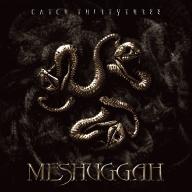Meshuggah's roots were planted in 1985. Originally named Metallien, the founding lineup included frontman Roger Olofsson, guitarists Peder Gustafsson and Fredrik Thordendal, bassist Janne Wiklund, and drummer Örjan Lundmark. After their demos made the rounds, the group split. Thordendal continued with a different lineup and name. The original Meshuggah roster also included vocalist Jens Kidman, guitarist Johan Sjögren, bassist Jörgen Lindmark, and drummer Per Sjögren. A handful of demos followed before Kidman left to form Calipash; the surviving members of Meshuggah soon disbanded. When the vocalist left his own outfit, he and Thordendal agreed to reclaim the Meshuggah mantle.
In 1989, the band released a three-song mini-LP. After signing to Nuclear Blast (and swapping Lundgren for drummer Tomas Haake), they issued the full-length Contradictions Collapse in 1991. Second guitarist Mårten Hagström was recruited for 1993's None EP, followed two years later by Selfcaged; in the interim, however, the group was forced to maintain a low profile -- first Thordendal severed a finger in a carpentry accident, then Haake injured his hand in a mysterious grinder mishap. Destroy Erase Improve appeared later in 1995, and won over critics with its heady tempos and abstract approach. In 1997, Meshuggah returned with The True Human Design EP; that same year, Thordendal's side project, Special Defects, released their LP Sol Niger Within. Meshuggah reunited for 1998's Chaosphere, a thunderous, almost unbearably dense album in its compositional makeup and dynamic scope. Several successful tours followed, and their abilities caught the attention of mainstream music magazines.
Once they left the touring circuit, Meshuggah were surprisingly quiet -- only a widely criticized rarities disc marked the time. In summer of 2002, they returned with the controversial charting Nothing that placed in the Top 200 -- they were the first band on Nuclear Blast to do so. The band slowed tempos to a nearly glacial pace, introduced eight-string guitars for a more expansive tonal palette, added slivers of psych, and explored tonal and modal dissonance. Unique in almost every way, the album didn't make much of a mainstream impact but had metal fans banging their heads to its 7/4 tempos and esoteric lyrics. A good word from Ozzy Osbourne's son Jack scored them a spot on the annual Ozzfest tour, where they flourished on the second stage, often stealing the show with their original and savage math metal.
After a brief break, Meshuggah released the I EP in 2004. Comprised of a single epic-length track, its complex arrangements and sonic experiments foreshadowed the circular, grinding grooves and melodic orchestration on 2005's Catch Thirty-Three. Though divided into 13 sections, it was essentially a single, suite-like, 47-minute composition. It marked the first time the band used programmed drums as a compositional tool. The set entered the Top 200 its first week of release and was nominated for a Swedish Grammy.
After touring, Meshuggah returned to the studio and spent more than a year recording 2008's obZen. Released in March in advance of a world tour, the set drew acclaim --and expanded the band's global fan base-- for its hooky return to thrash and mathy death metal without sacrificing compositional focus or technical innovation. The melodic orchestration at the heart of Catch Thirty-Three was replaced wholesale by a direct, almost industrial approach to riffing and rhythm. It too was nominated for the Swedish Grammy award in the "Best Hard Rock" category. Alive, a concert DVD was released in February in Europe and the U.S.
When Meshuggah returned to the recording studio, they were almost poignantly aware of their countless imitators. To that end, they shifted gears again. Seventh album Koloss was issued in 2012 and took a slower, more groove-oriented approach to composition, resulting in a more organic atmospheric brutality focused on the perfect execution of intricate, precisely syncopated riffs than speed or soloing. The set charted in 13 countries and entered the Top 20 in the U.S. They followed with the single and video for the album tracks "I Am Colossus" and "Pitch Black" b/w "Dancers to a Discordant System (Live)," the following year, and the live audio/video release The Ophidian Trek appeared in 2014. During the summer of 2016, in cooperation with Nuclear Blast, Meshuggah released 25 Years of Musical Deviance, an anniversary vinyl box set limited to 1,000 copies. It served as a precursor to the band's October studio offering, The Violent Sleep of Reason and marked a return to recording basics as they cut the set live from the studio floor, just as they had their earliest demos. The album was lauded for its innovative deconstruction of the tropes in heavy music, and its complex compositional structures offered a good-natured critique of the entire metal genre and the "djent" sound. It was shortlisted for the Album of the Year Award by IMPALA (The Independent Music Companies Association).
After an initial round of touring dates, Meshuggah announced Thordendal's sabbatical in June 2017. He was replaced on tour by Scar Symmetry's Per Nilsson. In 2018, the band received a U.S. Grammy nomination for the single "Clockworks" in the Best Metal Performance category.
In 2019, Hagström hinted to an interviewer that the band were already working on a new album. They toured that summer and into the beginning of 2020 when the COVID-19 pandemic shut down the world. When they reconvened in the studio in March 2021, Thordendal had returned to the fold. Single "The Abysmal Eye" appeared in January 2022 -- it was the first new music from Meshuggah in nearly six years. It was followed in February by "Light the Shortening Fuse," and the 13-track, 66-minute full-length Immutable. ~ Jason Ankeny & Thom Jurek, Rovi


















